Seton Hall University Professor Emeritus Richard Connors will commemorate the 100th anniversary of the outbreak of World War I with a lecture Wed., Oct. 8, 3 p.m. in the Walsh Library Archives Reading Room on the South Orange campus. “World War I: A Centennial Perspective,” will explore the military and geopolitical ramifications of the Great War that was supposed to be “the war to end all wars.” The public is invited to the free lecture.
“Historians see World War I as the defining event of the 20th century. It destroyed four empires and marked the end of a Europe-centered world,” said Connors. “What emerged were a new perspective and a new reality – a world society, a global economy, a world politics. When we think of the 20th century – of the U.S. and Japan as world powers, of Hitler, Mussolini and Stalin, of World War II and the Cold War, of Middle East and Balkan crises – the seeds go back to 1914-19.”
In conjunction with his lecture, Connors’ collection of World War I models, maps, books, posters and pictures are on exhibit at the Msgr. William Noé Field Archives and Special Collections Center in the University library.
We are pleased to have Dr. Connors bring his knowledge of World War I to Seton Hall and share his personal collection with us. A natural story-teller, his talk will generate interest in a war which saw “so many people die for so little reason” – a war which changed how wars are fought and how we see our country and our world. “Our personal and cultural perspectives are largely shaped by our history,” he said. “That’s why it is so important to revisit it regularly.”
Blog
New Finding Aids: Summer 2014
Several collections in the Archives and Special Collections Center have received new finding aids over the summer, allowing researchers access to new materials on a variety of topics.
Robert F. Garner papers, 1946-1998 (bulk 1976-1987), ADN 0003.010: Robert F. Garner (1920-2000) served as priest and bishop in Hudson and Essex counties in NJ. This collection includes correspondence, video recordings, a sick call box, and memorabilia depicting his service to local communities.
Charles J. McDonnell papers, 1965-2008 (bulk 1994), ADN 0003.019: Charles J. McDonnell (1928-) served as Auxiliary Bishop of Bergen and Essex counties in NJ as well as Brigadier General in the U.S. Army. This collection includes correspondence, photographs, and memorabilia depicting his service to the church and armed forces.
Collection on the Auxiliary Bishops of the Archdiocese of Newark, 1909-1978, ADN 0003: The Collection on the Auxiliary Bishops of the Archdiocese of Newark includes materials related to the consecration, activities, and death of several auxiliary bishops of the Archdiocese of Newark.
Collection on papal honors of the Archdiocese of Newark, 1929-1983, ADN 0041: The Collection of Papal honors of the Archdiocese of Newark includes materials related to the nomination of priests and lay people for papal honors, also called papal decorations.
Rita Murphy papers and phonographs, 1898-2001, Mss 0015: Papers and phonograph records relating to Rita Murphy’s interest in Ireland and Irish culture. Although phonographs are not able to be listened to in the reading room, accommodations can be made for interested researchers. See our User Guide and Reproduction Policies for more information.
Office of the President & Chancellor of Seton Hall University: Robert T. Conley records, 1977-1979, SHU 0003.017: Robert Conley was the 17th president of Seton Hall University and served in that capacity from 1977 to 1979. Dr. Conley was the first official lay president of Seton Hall. The Office of the President & Chancellor of Seton Hall University: Robert Conley records include files and reports gathered and produced by Dr. Robert Conley during his time as President of Seton Hall University.
As always, this work could not have been accomplished without the dedication of our staff, student workers, and interns. Now that summer is over and the fall semester is picking up, keep an eye out for more resources and information in the coming months!
WWI: A Centennial Exhibition
The first installment of our three-part series commemorating the 100th anniversary of the Great War is now on display in the Msgr. William Noé Field Archives and Special Collections Center, and will remain until 31 October 2014.
This portion of the exhibit is focused on the beginning of the war, including a set of lead figurines depicting the assassination of Archduke Francis Ferdinand, and a diorama of a trench which illustrates the crowded, cramped quarters that were endured by soldiers on the Western Front.
In addition, there are figurines depicting early French and German uniforms, models of planes used in the war, and figurines depicting Ottoman soldiers during the Gallipoli campaign in 1915. The objects in the exhibit curated by Brianna LoSardo, Special Collections Assistant, are on loan from former history professor and Provost, Dr. Richard Connors.
Throughout the exhibit we are showcasing rare books from our Archives which contain photographs and illustrations of the war, as well as a collection of poetry written during and about the Great War. Maps and art prints complete the display.
The exhibit can be viewed any time the Walsh Library is open, in the display cases across from Walsh Gallery. It will be followed by the second installment on 1 November 2014.
Archives closes 2 weeks in August for work behind the scenes
During the weeks of August 4-8 and 18-22, 2014 the Archives will be closed to researchers so that we can accomplish some work in the vault that we cannot do when school is in full session in the Fall and Spring semesters. This work will help us to improve our service. We appreciate your understanding and apologize for any inconvenience.
Msgr. William Noé Field Archives and Special Collections Center Commemorates the Centenary of World War I
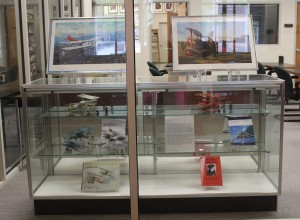
On 28 June, 1914, Archduke Franz Ferdinand of Austria-Hungary, and his wife, Duchess Sophia, were assassinated by a Bosnian Serb, setting in motion the events that would erupt into what became known as the Great War, the War to End all Wars, World War I. As we know, it did not end all war, but as commemorations take place over the next year to remember the 100th anniversary, we will be adding our commemoration by means of an exhibit in the Msgr. William Noé Field Archives and Special Collections Center, ground floor, Walsh Library.

We begin with items that refer to two famous pilots – the Red Baron, Manfred von Richthofen (2 May 1892 – 21 April 1918), and The American Ace of Aces, Eddie Rickenbacker, (October 8, 1890 – July 27, 1973).
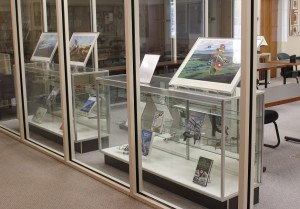
Then in August, we will present three installments over nine months combining models, dioramas, figures and prints with archival material to commemorate the inception of the Great War.
The first installment, running from 1 August through 31 October, 2014, includes figures of the assassinations of the Archduke and his wife, a British trench and armored car, maps of Europe at the beginning of the War and of the Schleiffen Plan, illustrations of French and German uniforms, and figures representing the Galipoli Campaign which began 15 April 1915. Poems by writers including Clinton Scollard, Katharine Tynan, Rupert Brooke, Josephine Burr, G. K. Chesterton, John Drinkwater, Violet Gillespie, Corporal Malcolm C. Murray and Joyce Kilmer, along with plates from rare volumes of the time, will amplify these exhibits.
Second, from 1 November 2014 to 31 January 2015 we will show models of British, French and German artillery, the Red Baron’s ACE01 Fokker DR1, Eddie Rickenbacker’s Sopwith Camel, as well as other planes, tanks and armored cars paired with archival memories of the time.
Last, from 1 February – 30 April 2015 we will show a map of Europe after the War, British and German foot soldiers, a regimental aid post where care was provided to the wounded, women in the war, T. E. Lawrence and the Arab Revolt, along with poems and depictions of uniforms.
Please come to enjoy the evolution of our exhibit.
Seton Family Album Digital Photographs and Publicity
The Seton family album has been receiving a lot of attention from the Seton Hall community. Recently, the album was featured on the University’s home page in a news story, showing a selection of the images and describing the album and related resources.
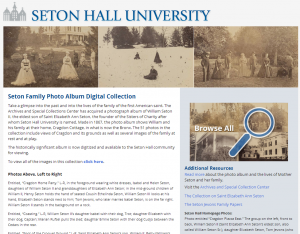
The album and digital collection were also featured in a Setonian article: Hall history told through old photos, in a story written by Abbas Khan Cook.
The entire album was digitally photographed by Milan Stanic, the University photographer, with the help of the University Advancement Office. Staff of the Archives and Special Collections Center transcribed the handwritten captions on the images and made all 51 photographs available in a new digital collection, the Seton Family Photograph Album Digital Collection.
The A&SCC is delighted to see this unique and fascinating album receive attention from the Seton Hall community. We hope everybody takes these opportunities to view the images and catch a glimpse of the life of the Seton family in 1867.
New Finding Aids: Spring 2014
The Archives and Special Collections Center continues to work hard to bring more of our resources to the community. A number of new finding aids have been published recently, thanks in large part to the efforts of our students, volunteers, and staff behind the scenes.
A number of Seton Hall collections have been presented with new finding aids, which will allow students, administration, and scholars to find more on the history of how this institution has developed over the years. Highlights include the Office of the President & Chancellor of Seton Hall University: Thomas G. Fahy records, 1970-1976, SHU 0003.015, which include records from Msgr. Thomas Fahy’s time as University President, during which he oversaw significant physical growth as well as progress in equal access to education for minorities, improved governance, and student affairs. Also new this year are finding aids for the WSOU records, 1948-1986, SHU 0041; Teaching, Learning, and Technology Center of Seton Hall University records, 1995-2002 (bulk 1997-1998), SHU 0038; and Stillman School of Business records, 1977-2006 (bulk 1980-1989), SHU 0015.
The Archdiocese of Newark collections have also been augmented with a new group of finding aids for the papers of priests and bishops, and the records of constituent groups and offices within the Archdiocese. Among these, the Jerome A. Pechillo papers, 1927-1991 (bulk 1951-1990), ADN 0003.009; Charles P. Granstrand papers, 1963-1967, ADN 0004.032; George A. Clyde papers, 1955-2001, ADN 0004.022; and Men’s religious orders of the Archdiocese of Newark records, 1842-2011 (bulk 1940-1999), ADN 0011 document the experiences of priests, bishops, and religious men in the Archdiocese, while the Franklin Lakes Farms of the Archdiocese of Newark records, 1944-1961, ADN 0022; Bishop’s Relief Fund of the Archdiocese of Newark records, 1944-1966, ADN 0009; and Archdiocese of Newark Expansion Project records, 1960-1963, ADN 0021, among others, document the growth and outreach efforts of the Archdiocese over the years.
A collection that belongs to both Seton Hall and Archdiocese history is the Immaculate Conception Seminary records, 1868-2008, SHU 0023, a partially processed and partially described collection; the finding aid for this collection, although incomplete, is also now available for researchers to use.
The major Manuscript collection to receive a finding aid and a digital collection this year was the Seton family photograph album, 1867, Mss 0074, which has received special attention in this blog and elsewhere; also presented this year was the Richard Markey collection of building dedication programs, 1980-2006, Mss 0057.
These and many other collections are available to researchers, and processing work continues to make yet more collections accessible. Stay tuned for more information and resources!
Better Living Through Chemistry & Setonia – An Exhibit Honoring the 50th Anniversary of the First Ph.D. Program on Campus
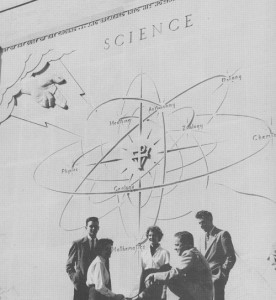 The history of Chemistry at Seton Hall had its start as a study option from the beginning days of its move to South Orange as part of the early “Mathematical Course” during the mid-nineteenth century. From here, Chemistry became a very popular attraction from which pupils found a means of scientific expression that would expand greatly after World War II on both the undergraduate and graduate level prior to the introduction of doctoral level offerings by the mid-1960s. This discipline has subsequently grown and endured as an important major choice of many students into the present day. With this in mind, a celebration of Chemistry and its place on campus is presently on display at the Monsignor William Noé Field Archives & Special Collections Center.
The history of Chemistry at Seton Hall had its start as a study option from the beginning days of its move to South Orange as part of the early “Mathematical Course” during the mid-nineteenth century. From here, Chemistry became a very popular attraction from which pupils found a means of scientific expression that would expand greatly after World War II on both the undergraduate and graduate level prior to the introduction of doctoral level offerings by the mid-1960s. This discipline has subsequently grown and endured as an important major choice of many students into the present day. With this in mind, a celebration of Chemistry and its place on campus is presently on display at the Monsignor William Noé Field Archives & Special Collections Center.
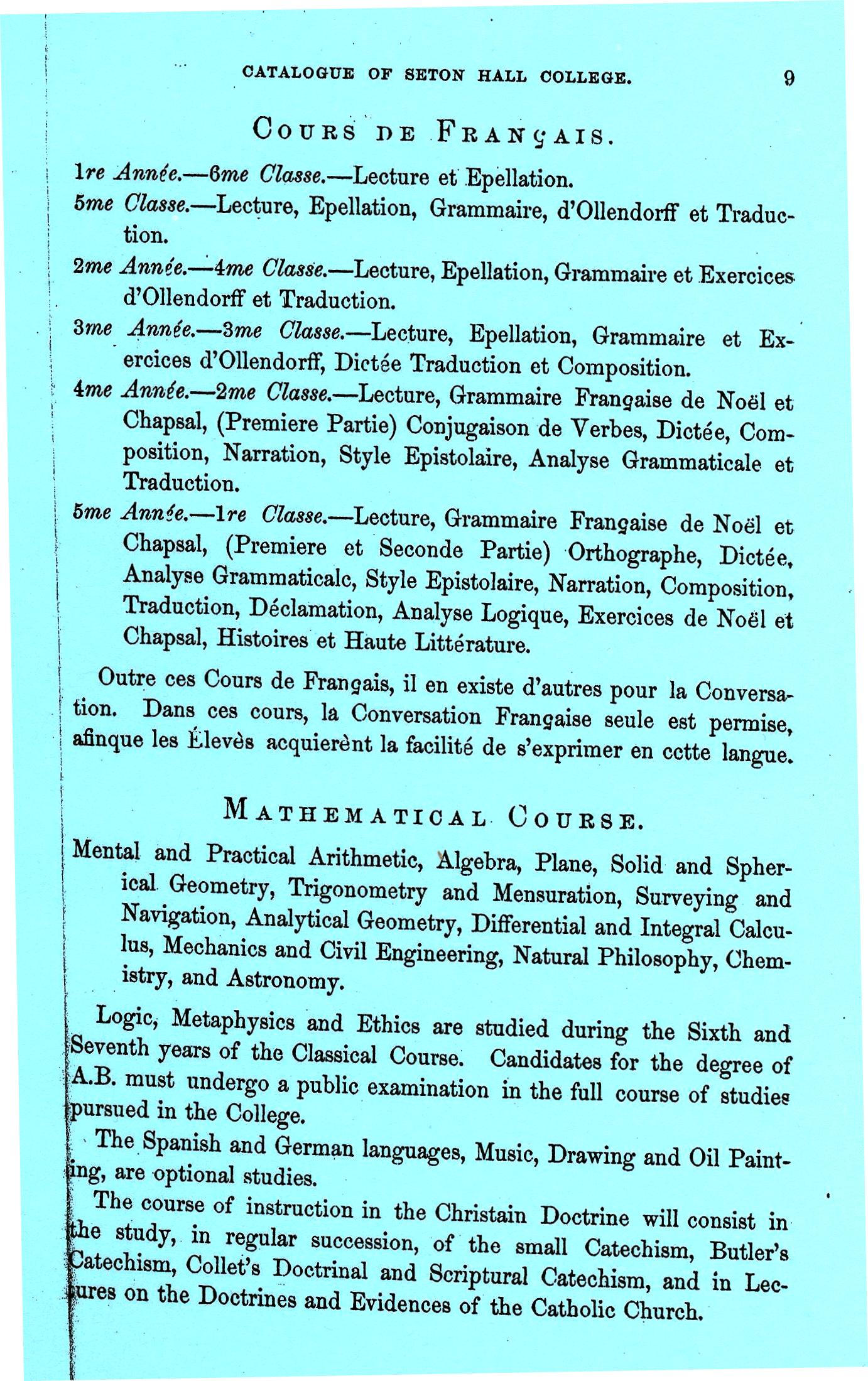 This exhibit will provide a brief textual and visual overview showcasing the evolution of how the wonder of Chemistry has made its impact on the life of students, faculty, and the world at large. Included are various early nineteenth century written works and mid-twentieth century primers from our Rare Book and Setonia Text Book Collections that celebrate the development of Chemistry experimentation and have practical applications to pioneering practitioners in the field.
This exhibit will provide a brief textual and visual overview showcasing the evolution of how the wonder of Chemistry has made its impact on the life of students, faculty, and the world at large. Included are various early nineteenth century written works and mid-twentieth century primers from our Rare Book and Setonia Text Book Collections that celebrate the development of Chemistry experimentation and have practical applications to pioneering practitioners in the field.
On a more local level, viewers will find lecture notes taken by Seton Hall student Alden A. Freeman during the 1879-80 term, information about pioneering faculty members, and photographic examples that show the evolution of lab space and structures over the years from Alumni Hall to the present day McNulty Science complex. Of particular note is the dissertation and a biographical sketch acknowledging the contributions of our first Ph.D. recipient Dr. William N. Knopka during the mid-1960s. Additional textual examples from the University Archives and tools of the trade on loan through the courtesy of Mr. David Edwards from the Science Department show further details regarding the curriculum, public programming, and student life associated with the Chemistry Department over its last five decades of educational outreach to the scientific community.
Hopefully your reaction will be a positively charged one while taking in the historical relevance of how Chemistry and Seton Hall evolved successfully over time.
The Archives presents the Seton family photograph album
Last year, the Archives and Special Collections Center acquired materials of special importance to the Seton Hall community: the Seton family photograph album and two books belonging to the Seton family.
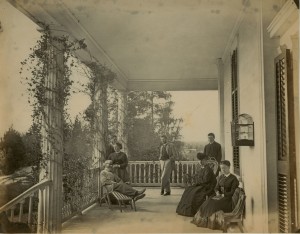
Elizabeth Ann Seton, the first American born saint, founded the first congregation of sisters in the United States, the Sisters of Charity; opened the first free Catholic school in the U.S., St. Joseph’s Academy; and is the namesake of Seton Hall University. Before converting to Catholicism in 1805 and founding an order of sisters, she was married to William Seton and had five children, all of whom were educated in Catholic schools.
William Seton II (later called William Seton Sr.) was Elizabeth’s oldest son, born in 1796, and after completing his education he joined the United States Navy, rising to the rank of Lieutenant. He married Emily Prime in 1832 and the couple had seven children of their own before Emily died in 1854. William made a home in New York, in what is now the Bronx, called Cragdon. This estate had a large home, barns, and extensive grounds; it overlooked the village of East Chester and offered beautiful views of the surrounding area.
The Seton family photograph album was made in 1867. The photographer(s) is unknown, but the first page of the album is inscribed to William Seton from Thomas Jevons (who later married William’s daughter Isabel) and Alfred Booth. Jevons and Booth were British businessmen, and it isn’t clear how they came to be acquainted with the Setons, but the album was apparently a gift from the two, featuring photographs of the Setons’ home and surrounds.
The 51 photographs in the album include hand-written descriptions of each image and may have been written by one of William Seton’s children, as he is referred to as Father in at least one image. Many of the images are of the Cragdon house and the areas nearby, including trees, a brook, meadows, ledges, caves, and the nearby East Chester village. A number of the images also include members of the family, usually identified in the caption, and friends and family, as well as clearly beloved pet dogs, also usually named. Winter, spring, and summer are represented in the images, as are activities appropriate to each, including sledding (called “coasting”) and a fishing party.
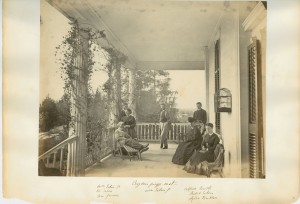
Although the original cover of the album is missing, the photographs are in good condition and only a little faded, with almost no silvering (a phenomenon of many old photographs in which dark areas turn silver due to chemical changes over time). These lovely images are quite striking now, as they show an area that would today bear little resemblance to the past captured here. For those interested in Mother Seton’s family and the history of Catholics in America in the 19th century, these images depict a genteel family and their home. For those interested in other historical figures, the images include Army officers of the Civil War and active businessmen of New York and England, as well as the costumes of men and women of the upper-middle and serving classes in 1867. For those interested in nature, the images show trees, flowers, and scenery long vanished from where they stood when these pictures were taken, although the current Seton Park in the Bronx may include areas depicted here.
This album is available for research in the Archives and Special Collections Center; view the finding aid for the Seton family album, 1867, Mss 0074. Only one photograph from the album has been digitized at this time but it is hoped that more will follow. Also acquired with the album were two books belonging to William Seton, the Odyssey of Homer and Select Pieces on Religious Subjects by Effingham Warner, both of which are due to be cataloged and made available to researchers. Other resources related to Mother Seton and the Seton family can be found in the A&SCC: Collection on Saint Elizabeth Ann Seton, 1840-2006, Mss 0006 and Seton Jevons family papers, 1780s-1930, Mss 0005.
The Donald M. Payne papers come to Seton Hall
The Archives and Special Collections Center at Seton Hall University is pleased to announce the acquisition of the Donald M. Payne papers, a new manuscript collection of congressional papers from the late Donald M. Payne, a member of the United States House of Representatives from New Jersey’s 10th district from 1989-2012.
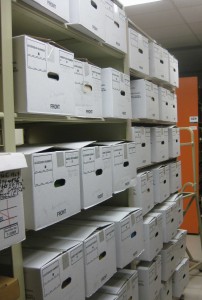
Donald Payne was born and raised in Newark, N.J., and graduated from Seton Hall University in 1957. He became the first African American Congressman from New Jersey when he was elected to the House of Representatives in 1988, and served ten consecutive terms. During his time in Congress, Representative Payne served on the Committee on Foreign Affairs and the Committee on Education and the Workforce. Mr. Payne died in 2012 and was succeeded in Congress by his son, Donald Payne, Jr.
The Donald Payne papers document Representative Payne’s time as a congressional representative, including legislative documentation, research files, newsclippings, photographs, and audio-video recordings. About 43 linear feet of materials have been accessioned by the A&SCC, and the materials will soon be processed and made available to researchers. The A&SCC and University Libraries are very excited to have acquired this important collection of political papers and look forward to connecting this material to users. Stay tuned for more information!

